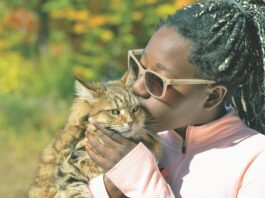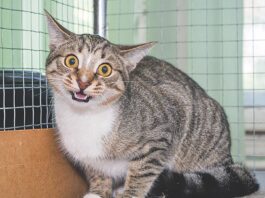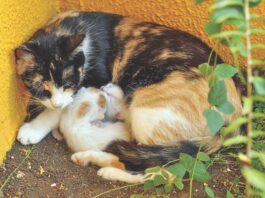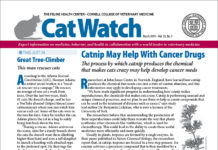Great Tree-Climber
According to the Atlanta Journal-Constitution (AJC), Normer Adams, a retired social worker, is a treed-cat rescuer on a rampage. He rescues an average of one cat a week from trees. Over the last two years, thats 91 cats. He doesnt charge, and he has a YouTube channel (https://tinyurl.com/cattreerescue) where you can watch him rescue each cat. Some of the cats were in the tree for days. Once he reaches the cat, Adams places the cat in a bag to safely bring him back down the tree.
Catnip May Help With Cancer Drugs
Researchers at John Innes Centre in Norwich, England, have learned how catnip produces the chemical that sends cats into a state of wanton abandon, and this information may apply to developing cancer treatments.
Download the Full March 2019 Issue PDF
Download the Full March 2019 Issue PDF…
March Special Dates
Kristen Levines Pet Living 2019 calendar (kristenlevine.com) lists these significant days in March for cat lovers:
Museum-Loving Cats
Two cats have been trying for over two years to make their way into a museum in Japan. A guard at the Hiroshima Onomichi City Museum actually spends most of his day shooing the cats away from the automatic doors.
Restricted pet sales increasing
California pet stores can now only sell dogs, cats, and rabbits if they come from shelters or non-profit rescue groups. The law became effective January 1. Under the law, individuals are still allowed to buy from private breeders, but stores are prohibited from doing so.
Free Download AVMA Coloring Book:
The American Veterinary Medical Association has a downloadable PDF for your kids called Owning a Pet:
Feline Pancreatitis May Be Chronic
When pet owners think of pancreatitis, often the image that comes to mind is a dog who does a garbage raid and consumes a bunch of spoiled or fatty food. Dietary indiscretion usually is not considered a cause of pancreatitis in cats, perhaps because cats are more fastidious in their eating habits!
Good-Bye Severe Sinus Problems
Despite the disturbing definition that will first appear if you do an internet search for rhinotomy (mutilation or amputation of the nose), this procedure can be beneficial to cats experiencing chronic nasal problems. There are two primary surgical techniques: dorsal rhinotomy and ventral rhinotomy. In both cases, the surgeon removes part of the bone surrounding the cats sinuses in order to gain access to the sinus and remove the source of the problem, be it a foreign body, a tumor, or infected tissues.
Tooth Resorption
Tooth resorption, still sometimes referred to as feline odontoclastic resorptive lesions or FORLs, is a common and painful condition affecting cats teeth. In cats with this condition, one or more teeth slowly break down and resorb, exposing the pulp of the tooth. Estimates of how many cats are affected by tooth resorption range from 20 to 60 percent.
Litterbox Covering at 1 Month of Age
Why cats cover their feces in a litterbox is a subject of debate, but we know it begins at a young age. Kittens cover their eliminations by 1 month of age by raking loose dirt over the excrement, says Pamela J. Perry, DVM, Ph.D. The specific site and substrate tend to be learned from the queen. It is believed that the odor of the feces initiates the burying behavior. In fact, some cats will cover the feces of other cats in the household.
AVMA Releases Stats on Pet Ownership
Pet ownership is on the rise in the United States, with dogs leading the way and large increases in less traditional pets like poultry and lizards, according to the American Veterinary Medical Association (AVMA).












